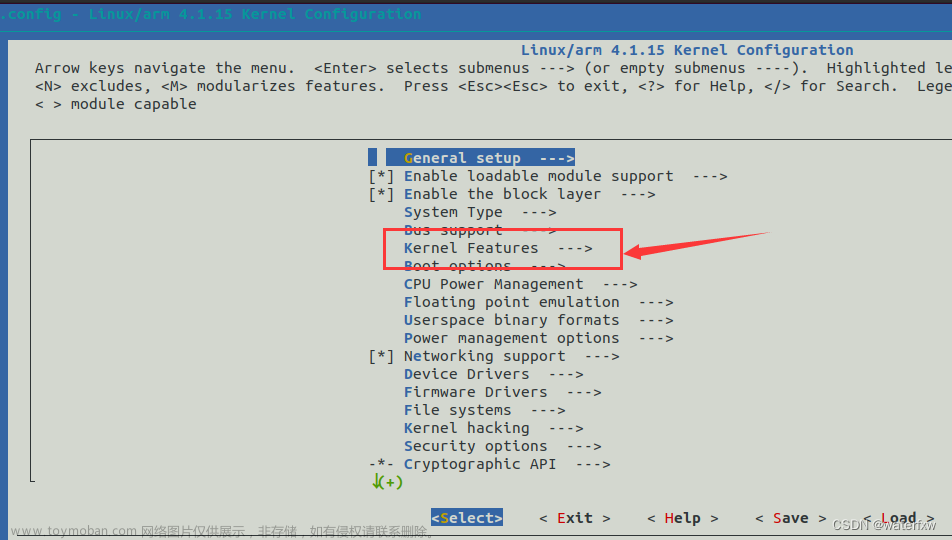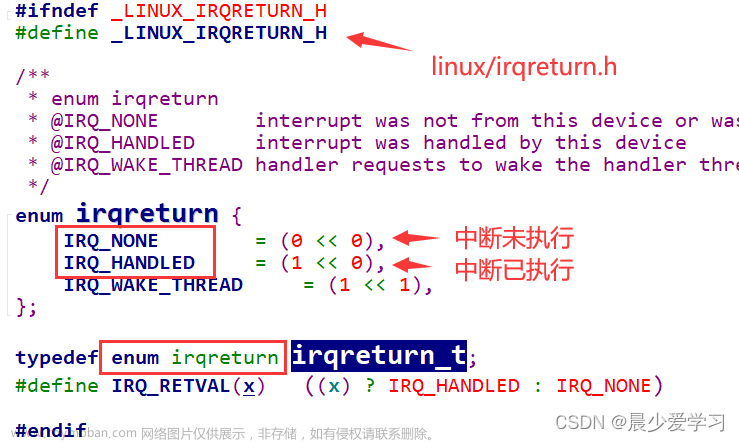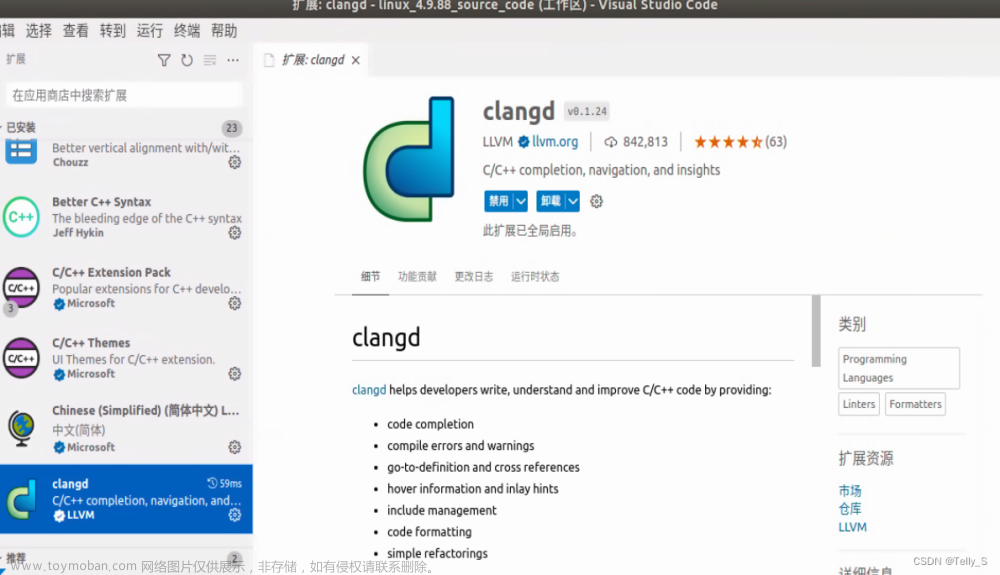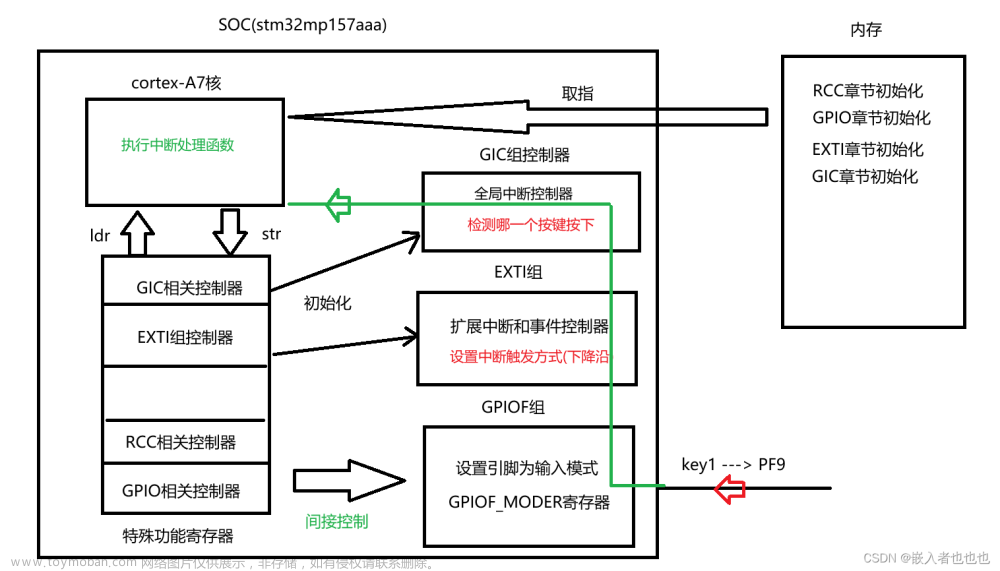编写LED灯的驱动,使用GPIO子系统,里面添加按键的中断处理
1.应用程序发送指令控制LED亮灭
2.按键1 按下,led1电位反转 按键2按下,led2电位反转 按键3 按下,led3电位反转
功能函数文章来源:https://www.toymoban.com/news/detail-678470.html
#include<stdlib.h>
#include<stdio.h>
#include <sys/types.h>
#include <sys/stat.h>
#include <fcntl.h>
#include<unistd.h>
#include<string.h>
#include<sys/ioctl.h>
//功能码
#define LED_ON _IOW('l',1,int)
#define LED_OFF _IOW('l',0,int)
int main(int argc, char const *argv[])
{
char buf[128] = {0};
int a,b;
int fd;
while (1)
{
printf("请输入要控制的灯:0(led1) 1(led2) 2(led3)\n");
scanf("%d",&a);
if(a == 0)
{
fd = open("/dev/myled0", O_RDWR);
if (fd < 0)
{
printf("打开设备文件失败\n");
exit(-1);
}
}
else if(a == 1)
{
fd = open("/dev/myled1", O_RDWR);
if (fd < 0)
{
printf("打开设备文件失败\n");
exit(-1);
}
}
else if(a == 2)
{
int fd = open("/dev/myled2", O_RDWR);
if (fd < 0)
{
printf("打开设备文件失败\n");
exit(-1);
}
}
printf("请输入控制命令:0(关闭) 1(开灯)>");
scanf("%d",&b);
switch(b)
{
case 1:
ioctl(fd,LED_ON);
break;
case 0:
ioctl(fd,LED_OFF);
break;
}
close(fd);
}
return 0;
}驱动代码文章来源地址https://www.toymoban.com/news/detail-678470.html
#include <linux/of_irq.h>
#include <linux/interrupt.h>
#include <linux/of_gpio.h>
#include <linux/gpio.h>
#include <linux/init.h>
#include <linux/module.h>
#include<linux/fs.h>
#include<linux/io.h>
#include<linux/device.h>
//功能码
#define LED_ON _IOW('l',1,int)
#define LED_OFF _IOW('l',0,int)
unsigned int major;//定义一个变量保存主设备号
char kbuf[128]={0};
struct class *cls;
struct device*device;
struct device_node *dev_led;
struct device_node *dev;
unsigned int irqno1,irqno2,irqno3;
struct gpio_desc *gpiono1;
struct gpio_desc *gpiono2;
struct gpio_desc *gpiono3;
/*
myirq{
interrupt-parent=<&gpiof>;//引用中断父节点
interrupts=<9 0>,<7 0>,<8 0>;//声明和中断父节点的关系 9表示索引号,0表示默认设置
};
*/
//中断处理函数
irqreturn_t myirq_handler1(int irq,void *dev)
{
gpiod_set_value(gpiono1, !gpiod_get_value(gpiono1)); // LED1
return IRQ_HANDLED;
}
irqreturn_t myirq_handler2(int irq,void *dev)
{
gpiod_set_value(gpiono2, !gpiod_get_value(gpiono2)); // LED2
return IRQ_HANDLED;
}
irqreturn_t myirq_handler3(int irq,void *dev)
{
gpiod_set_value(gpiono3, !gpiod_get_value(gpiono3)); // LED3
return IRQ_HANDLED;
}
//封装操作方法
int mycdev_open(struct inode *inode, struct file *file)
{
int a = inode->i_rdev;//获取当前设备文件对应的设备号
file->private_data=(void*)MINOR(a);//将次设备号保存到当前文件的file结构中
printk("%s:%s:%d\n",__FILE__,__func__,__LINE__);
return 0;
}
long mycdev_ioctl(struct file *file, unsigned int cmd, unsigned long arg)
{
unsigned int a=(unsigned int)file->private_data;
switch(a)
{
case 0:
if(cmd == LED_ON)
gpiod_set_value(gpiono1,1);
else
gpiod_set_value(gpiono1,0);
break;
case 1:
if(cmd == LED_ON)
gpiod_set_value(gpiono2,1);
else
gpiod_set_value(gpiono2,0);
break;
case 2:
if(cmd == LED_ON)
gpiod_set_value(gpiono3,1);
else
gpiod_set_value(gpiono3,0);
break;
}
return 0;
}
int mycdev_close(struct inode *inode, struct file *file)
{
printk("%s:%s:%d\n",__FILE__,__func__,__LINE__);
return 0;
}
//定义一个操作方法结构体变量并且初始化
struct file_operations fops={
.open=mycdev_open,
.release=mycdev_close,
.unlocked_ioctl = mycdev_ioctl,
};
static int __init mycdev_init(void)
{
int i;
// 字符设备驱动注册
major = register_chrdev(0, "mychrdev", &fops);
if (major < 0)
{
printk("字符设备驱动注册失败\n");
return major;
}
printk("字符设备驱动注册成功:major=%d\n", major);
// 向上提交目录
cls = class_create(THIS_MODULE, "myled");
if (IS_ERR(cls))
{
printk("向上提交目录失败\n");
return -PTR_ERR(cls);
}
printk("向上提交目录信息成功\n");
// 向上提交设备节点信息
for (i = 0; i < 3; i++)
{
device = device_create(cls, NULL, MKDEV(major, i), NULL, "myled%d", i);
if (IS_ERR(device))
{
printk("向上提交设备节点信息失败\n");
return -PTR_ERR(device);
}
}
printk("向上提交设备节点成功\n");
int ret1,ret2,ret3;
//解析按键的设备树节点
dev = of_find_node_by_path("/myirq");
if(dev==NULL)
{
printk("解析设备树节点失败\n");
return -EFAULT;
}
printk("解析设备树节点成功\n");
//根据设备树节点的路径解析设备树信息
dev_led = of_find_node_by_path("/leds");
if(dev_led==NULL)
{
printk("解析设备树信息失败\n");
return -EFAULT;
}
printk("解析设备树信息成功\n");
//根据设备树节点解析出软中断号
irqno1 = irq_of_parse_and_map(dev,0);//按键1索引号为0
irqno2 = irq_of_parse_and_map(dev,1);//按键2索引号为1
irqno3 = irq_of_parse_and_map(dev,2);//按键3索引号为2
if(!irqno1|!irqno1|!irqno2)
{
printk("解析软中断号失败\n");
return -ENXIO;
}
printk("解析软中断号成功 irqno=%d %d %d\n",irqno1,irqno2,irqno3);
//注册中断
ret1 = request_irq(irqno1,myirq_handler1,IRQF_TRIGGER_FALLING,"key1",NULL);
ret2 = request_irq(irqno2,myirq_handler2,IRQF_TRIGGER_FALLING,"key2",NULL);
ret3 = request_irq(irqno3,myirq_handler3,IRQF_TRIGGER_FALLING,"key3",NULL);
if(ret1|ret2|ret3)
{
printk("注册中断失败\n");
return -EFAULT;
}
printk("注册中断成功\n");
//根据解析到的设备树信息解析出led的gpio编号
// 申请gpio_desc对象并设置输出为低电平
gpiono1 = gpiod_get_from_of_node(dev_led, "led1-gpios", 0, GPIOD_OUT_LOW, NULL);
if (IS_ERR(gpiono1))
{
printk("申请gpio1对象失败\n");
return -PTR_ERR(gpiono1);
}
printk("申请gpio1对象成功\n");
gpiono2 = gpiod_get_from_of_node(dev_led, "led2-gpios", 0, GPIOD_OUT_LOW, NULL);
if (IS_ERR(gpiono2))
{
printk("申请gpio2对象失败\n");
return -PTR_ERR(gpiono2);
}
printk("申请gpio2对象成功\n");
gpiono3 = gpiod_get_from_of_node(dev_led, "led3-gpios", 0, GPIOD_OUT_LOW, NULL);
if (IS_ERR(gpiono3))
{
printk("申请gpio对象失败\n");
return -PTR_ERR(gpiono3);
}
printk("申请gpio3对象成功\n");
return 0;
}
static void __exit mycdev_exit(void)
{
//销毁设备节点信息
int i;
for(i=0;i<3;i++)
{
device_destroy(cls,MKDEV(major,i));
}
//销毁目录信息
class_destroy(cls);
//注销字符设备驱动
unregister_chrdev(major,"mychrdev");
//注销中断
free_irq(irqno1,NULL);
free_irq(irqno2,NULL);
free_irq(irqno3,NULL);
// 灭灯
gpiod_set_value(gpiono1, 0);
// 释放gpio编号
gpiod_put(gpiono1);
gpiod_set_value(gpiono2, 0);
gpiod_put(gpiono2);
gpiod_set_value(gpiono3, 0);
gpiod_put(gpiono3);
}
module_init(mycdev_init);
module_exit(mycdev_exit);
MODULE_LICENSE("GPL");到了这里,关于驱动开发-按键中断的文章就介绍完了。如果您还想了解更多内容,请在右上角搜索TOY模板网以前的文章或继续浏览下面的相关文章,希望大家以后多多支持TOY模板网!












